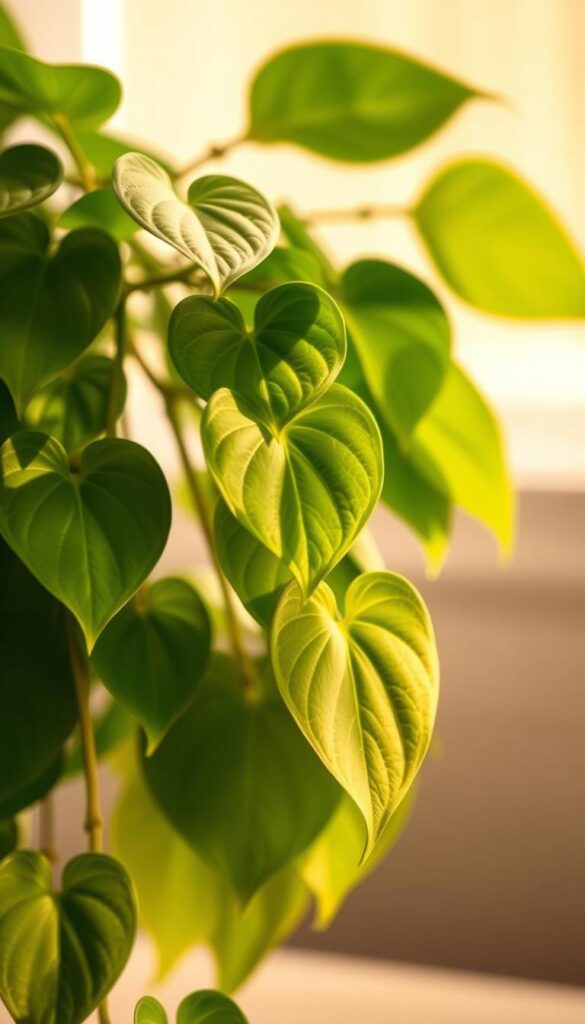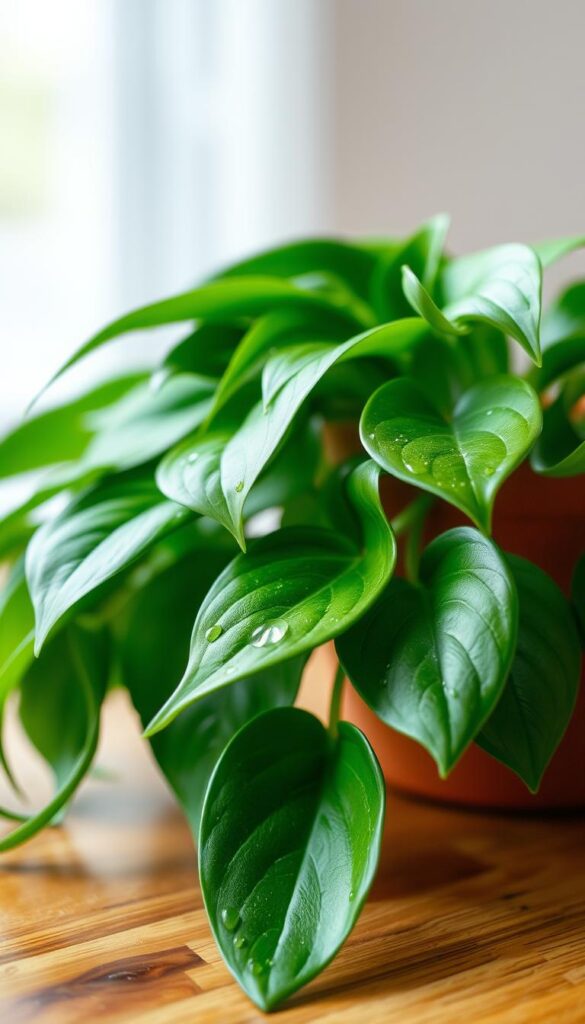I still remember the first time I brought home my pothos plant. It was a small, unassuming thing, but it quickly became a beloved part of my indoor space. Over time, I noticed how resilient it was—thriving even when I occasionally forgot to water it. But I wanted to give it the best care possible, so I dove into learning the ins and outs of watering my pothos.
That’s when I realized the importance of understanding your plant’s specific needs. Pothos plants, also known as devil’s ivy, are surprisingly adaptable, but they still need the right care to stay healthy and lush. Proper watering is key, and it’s not just about pouring water into the pot. It’s about understanding when the soil is dry enough for another drink and how factors like temperature, humidity, and even the time of year play a role.
One of the biggest lessons I learned was the importance of proper drainage. Using well-draining soil and the right pot can make all the difference in preventing root rot. I also discovered that watering isn’t a one-size-fits-all task. During the growing season, my pothos might need water every week, while in the winter, it might only need a drink every few weeks. It’s all about balance and paying attention to those subtle cues, like droopy leaves or dry soil.
In this guide, I’ll share everything I’ve learned about how to water your pothos plant to keep it thriving. From the best methods to how to troubleshoot common issues, I’ll cover it all. Whether you’re a seasoned plant parent or just starting out, this guide will help you give your pothos the care it deserves.
Understanding My Pothos Plant’s Natural Needs
My pothos plant has taught me a lot about its preferences, especially when it comes to mimicking its natural habitat. Native to tropical climates, this houseplant thrives in conditions that echo its origins.
Recognizing Ideal Temperature and Humidity
I keep my pothos in a spot where the temperature stays between 70°-90°F, which seems to make it happiest. Humidity is another key factor—I’ve noticed it loves a humid environment, typically between 40-60%. On drier days, a quick misting helps maintain that glossy leaf appearance.
Importance of Well-Draining Soil and Proper Pot Selection
The soil I use drains quickly, much like the sandy soil found in its native habitat. I also ensure the pot has enough drainage holes to prevent waterlogging. I learned this the hard way once when poor drainage led to root issues.
Regularly checking soil moisture and considering the indoor environment helps me avoid overwatering. It’s all about balance and attention to detail to keep my pothos lush and thriving.
Crafting a Timely Watering Schedule for Your Pothos
Creating a consistent watering schedule for my Pothos has been a game-changer. It ensures my plant stays healthy without over- or under-watering.
Seasonal Adjustments and the Finger Test Method
The finger test is my go-to method for checking soil moisture. I insert my finger into the soil up to the first knuckle. If the top inch feels dry, it’s time to water. This simple technique prevents root rot and ensures the plant gets exactly what it needs.
In the summer, my Pothos thrives with weekly watering. The soil dries out faster due to higher temperatures and more sunlight. In contrast, during the winter, the plant is dormant, so I water every few weeks. This adjustment ensures the soil isn’t too moist, which can lead to root issues.

When I’m away, I adjust my schedule. For short trips, a self-watering pot works perfectly. If I’m gone longer, a friend helps keep my Pothos happy. I also consider indoor conditions like humidity and temperature, which can affect how quickly the soil dries out.
Humidity plays a big role. In drier months, I might water a bit more frequently. Temperature fluctuations also influence the schedule. Warmer rooms mean the soil dries faster, while cooler spaces slow down moisture loss.
Being flexible is key. Even with a set schedule, I always check the soil before watering. This ensures I’m not overwatering, which can be detrimental. By paying attention to these factors, I’ve developed a routine that keeps my Pothos lush and vibrant all year round.
Mastering the “pothos watering guide” for Lush Growth
Discovering the right watering technique has been a turning point for my pothos, transforming it into a lush and vibrant companion.
Deep, thorough waterings are essential, but so is letting the soil dry out between sessions. This balance prevents root rot and encourages healthy growth. Different pothos varieties may benefit from tailored methods, so it’s worth exploring what works best for yours.
By keeping an eye on soil moisture and root health, I ensure my plant develops strong, resilient vines. Consistent watering, paired with the right techniques, fosters a thriving pothos. Over time, I’ve refined my approach by blending expert advice with personal experience.
This guide shares proven methods that have boosted my plant’s health and appearance. I encourage you to experiment, adjusting techniques to suit your pothos variety and environment. With the right care, your pothos can flourish beautifully.
Watering Techniques: From Bottom-Up to Over-the-Soil Methods
When it comes to watering my pothos plant, I’ve found that the method matters just as much as the frequency. Over the years, I’ve experimented with two primary techniques: bottom watering and over-the-soil watering. Each has its unique benefits, and understanding when to use which can make a significant difference in your plant’s health.
Exploring the Benefits of Bottom Watering
Bottom watering involves placing the pot in a water-filled tray. This method allows the plant to absorb water through the drainage holes, ensuring even moisture distribution. It’s a great way to avoid overwatering and root rot. To set it up, I fill a tray with about an inch of water and let the pot sit for 10-15 minutes. This technique is especially useful during the growing season when the plant needs more moisture.
Tips for Effective Over-the-Soil Watering
Over-the-soil watering is more traditional but equally effective when done right. It’s helpful for flushing out accumulated salts and fertilizers. I water gently but thoroughly, making sure the top layer of soil is moist but not soggy. This method is ideal during cooler months when the plant is less active.

By alternating between these methods, I’ve found a balance that keeps my pothos thriving. Experimenting with both techniques can help you determine what works best for your plant’s specific needs and environment.
Troubleshooting Watering Issues and Avoiding Common Pitfalls
Recognizing when your plant is suffering from too much or too little water is crucial for its survival. Overwatering is the most common mistake, often leading to root rot, while underwatering can cause leaves to wilt and soil to become overly dry. By understanding the signs and taking prompt action, you can keep your plant healthy and thriving.
Signs of Underwatering vs. Overwatering
Spotting the differences between underwatering and overwatering can be tricky, but there are clear indicators. Underwatering often results in wilting leaves and dry soil, while overwatering leads to yellowing leaves and mushy roots. Both issues can harm your plant, so it’s important to address them quickly.
- Underwatering: Wilting leaves, dry soil, and slow growth.
- Overwatering: Yellowing leaves, mushy roots, and a sour smell from the soil.
How I Tackle Root Rot and Other Care Challenges
Root rot is a serious issue that can arise from overwatering. If you notice soft, mushy roots, it’s time to act. I repot the plant in well-draining soil and ensure the pot has proper drainage holes to prevent water stagnation. Regularly checking soil moisture and adjusting for seasonal changes helps maintain the right balance.
| Sign | Underwatering | Overwatering |
|---|---|---|
| Leaf Appearance | Wilting, dry, crispy edges | Yellowing, soft, dropping |
| Soil Condition | Dry, cracked | Waterlogged, sour smell |
| Root Health | Intact, possibly stressed | Mushy, rotting |
By staying vigilant and adjusting your care routine based on your plant’s responses, you can prevent these common pitfalls. Observing your plant’s condition and adjusting your watering schedule accordingly will help maintain its health and vitality.
Bringing It All Together for My Thriving Pothos
Bringing It All Together for My Thriving Pothos
After diving deep into the world of Pothos care, I’ve learned that success lies in balance and attention to detail. Tailoring your watering schedule to your plant’s needs, whether it’s once a week in summer or less frequently in winter, ensures it stays healthy. I’ve found that combining the finger test with a consistent schedule works wonders, allowing me to adjust as the seasons change.
When it comes to watering methods, both bottom-up and over-the-soil techniques have their merits. Bottom watering is great for even moisture during growth spurts, while over-the-soil helps flush out salts. I switch between them based on what my plant needs, ensuring the soil never stays waterlogged.
Monitoring your plant’s health is crucial. Signs of underwatering, like crispy leaves, or overwatering, like yellowing foliage, are clear indicators to adjust your care. If you notice root rot, repotting with fresh, well-draining soil is essential. Regular checks and quick action can prevent long-term damage.
Seeing my Pothos flourish under this regimen has been incredibly rewarding. It’s a testament to the impact of proper care, even for a low-maintenance plant. I encourage you to experiment with these techniques, finding what works best for your space and your plant’s unique needs.
Embrace the journey of plant parenthood and enjoy the process of nurturing your Pothos. Share your successes and learnings with fellow plant enthusiasts—after all, there’s joy in growing together!
